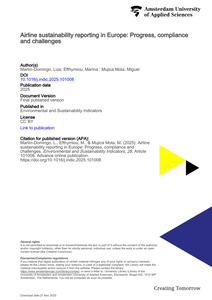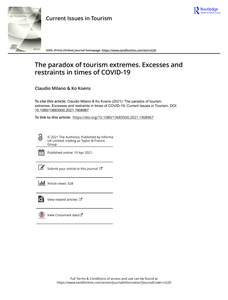This chapter gives an explication of the way in which the airline industry performs and reports on Corporate Sustainability and Responsibility (CSR). The connected case study (see Chap. 11) uses Air France-KLM as example. It becomes clear that airlines’ attitudes towards CSR depend on their geographic location, business model, and business performance. Their reporting on CSR is generally of lower quality and mainly relates to environmental issues, while social and ethical issues are apparently either considered of lesser importance or are more difficult to operationalise. Concerning the environmental impact, for example, it appears that airlines with a green public image tend to score low on a climate change index. This finding evokes concern that airlines might use CSR reporting mainly for PR purposes. This chapter includes a section on ethical reflection on CSR in the airline industry and concludes that a more fundamental approach to the issue of unsustainable growth of aviation, restricted volume growth, needs active and robust government guidance and cooperation with the airline industry.
LINK
This study systematically evaluates greenhouse gas (GHG) emissions reporting practices of European airline groups, covering both mandatory and voluntary key performance indicators (KPIs) under evolving regulatory frameworks. By analysing annual and sustainability reports from 16 major airline groups, the research identifies significant progress in the reporting of core metrics, with Scope 1 CO2 totals reported by 94 % and emissions intensity by 88 %, reflecting growing regulatory alignment and stakeholder expectations. However, persistent gaps remain: Scope 2 and Scope 3 reporting appears in only 56 % and 50 % of cases, respectively, while non-CO2 emissions are disclosed by just 38 %, despite forthcoming European Union Emissions Trading System (EU ETS) monitoring requirements. Reporting on sustainable aviation fuels (SAF) life-cycle emissions is limited (19 %), and CO2 offsetting disclosures are rare (6 %), complicating verification of decarbonisation claims and readiness for ReFuelEU Aviation and Carbon Offsetting and Reduction Scheme for International Aviation (CORSIA). The proliferation of voluntary KPI disclosures further complicates comparability due to a lack of standardization and clear definitions. These challenges are compounded by risks of greenwashing, where airlines selectively report favourable data such as emissions intensity, and greenhushing, where substantive achievements are under-communicated. The study concludes that while regulatory frameworks such as the Corporate Sustainability Reporting Directive (CSRD), the EU ETS, CORSIA, and ReFuelEU are driving improvements, further harmonization and methodological clarity are required to ensure transparency, comparability, and genuine progress toward aviation's climate goals.
DOCUMENT

This case study provides an analysis of the way in which a leading airline company in the world, Air France-KLM, applies Corporate Social Responsibility (CSR) within its business activities. The analysis is based on a conceptualisation of the term itself and the policy of and activities performed by the company. Other companies in the airline industry regard the Air France-KLM as a ‘good practice’ since it acts in an exemplary way on the integration of sustainability in the three major domains of CSR: economy, people and environment. It caters for environmental protection, customer experience, responsible human resources and local development. A challenge remains for the whole of the airline industry: to reconsider the very purpose of their business and start working on CSR 2.0. In CSR 2.0 sustainability, scalability, responsiveness and ‘glocality’ become part of an airline’s very DNA and are not regarded mere ‘defensive’ measurements for satisfying the ‘customer’ and politics.
LINK
In this paper we turn to the field of innovation management and the use of metaphors to address the question: what kind of alternative metaphors and narratives have some open-innovation organizations introduced highlighting and fostering knowledge-intensive organizational change? First we draw a comparative overview of characteristics of knowledge flows in general, that are specific for open innovation strategies, and that organizations want to highlight. Then we describe the use of metaphors by Philips, Pfizer, Chevron and RABO on their way towards open innovation strategies. Methodologically, the interpretation of the described metaphors will be based on a metaphor theory derived from the works of Joseph Campbell, Mircea Eliade, Carl Gustav Jung and Eugen Drewermann. Our analysis concludes by providing guidelines for necessary future research about the aptness of innovation metaphors for idea generation and knowledge creation.
DOCUMENT
Design educators and industry partners are critical knowledge managers and co-drivers of change, and design graduate and post-graduate students can act as catalysts for new ideas, energy, and perspectives. In this article, we will explore how design advances industry development through the lens of a longitudinal inquiry into activities carried out as part of a Dutch design faculty-industry collaboration. We analyze seventy-five (75) Master of Science (MSc) thesis outcomes and seven (7) Doctorate (PhD) thesis outcomes (five in progress) to identify ways that design activities have influenced advances in the Dutch aviation industry over time. Based on these findings, we then introduce an Industry Design Framework, which organizes the industry/design relationship as a three-layered system. This novel approach to engaging industry in design research and design education has immediate practical value and theoretical significance, both in the present and for future research. https://doi.org/10.1016/j.sheji.2019.07.003 LinkedIn: https://www.linkedin.com/in/christine-de-lille-8039372/
MULTIFILE

This paper seeks to highlight underlying issues of the tourism system that have led to tourism extremes of too much or too little tourism. Five phases are recognized that reflect different ways of dealing with too much tourism over time, after which the impact of a sudden lack of tourism is investigated in light of future renewal processes. This discussion highlights the remarkable capacity of the tourism industry to adjust to rapidly changing circumstances and crises, even when these cause anguish to individuals and within societies at large. The paper thus seeks to contextualize the current discussions regarding the transformation of tourism post COVID-19. It highlights the complexity of changing a tourism that multiple stakeholders depend on or have grown accustomed to. To come to a more balanced tourism, it is necessary to not only come up with alternative visions and strategies, but also to engage with the political economy nature of tourism development. A future research agenda should therefore also discuss facets of entangled power, social exclusion, inequalities and class differences to come to new reference points of what actually constitutes a more inclusive tourism success.
MULTIFILE

By use of a literature review and an environmental scan four plausible future scenarios will be created, based on the research question: How could the future of backpack tourism look like in 2030, and how could tourism businesses anticipate on the changing demand. The scenarios, which allow one to ‘think out of the box’, will eventually be translated into recommendations towards the tourism sector and therefore can create a future proof company strategy.
DOCUMENT

Emissions from aviation will continue to increase in the future, in contradiction of global climate policy objectives. Yet, airlines and airline organisations suggest that aviation will become climatically sustainable. This paper investigates this paradox by reviewing fuel-efficiency gains since the 1960s in comparison to aviation growth, and by linking these results to technology discourses, based on a two-tiered approach tracing technology-focused discourses over 20 years (1994-2013). Findings indicate that a wide range of solutions to growing emissions from aviation have been presented by industry, hyped in global media, and subsequently vanished to be replaced by new technology discourses. Redundant discourses often linger in the public domain, where they continue to be associated with industry aspirations of 'sustainable aviation' and 'zero-emission flight'. The paper highlights and discusses a number of technology discourses that constitute 'technology myths', and the role these 'myths' may be playing in the enduring but flawed promise of sustainable aviation. We conclude that technology myths require policy-makers to interpret and take into account technical uncertainty, which may result in inaction that continues to delay much needed progress in climate policy for aviation.
LINK
The world is changing in many ways. Digital developments follow each other in quick succession and have an impact on many existing structures. The future may be uncertain, but we can still learn from what has happened in the past. We usually know what we don’t want, but few of us know yet what we do want. Still, this is something we can only discover for ourselves, I think. Who are we? To what extent are we individuals and to what extent are we part of a collective? Remarkably, in these questions we can also find parallels with the Middle Ages.
LINK
In spite of renewed attention for practices in tourism studies, the analysis of practices is often isolated from theories of practice. This theoretical paper identifies the main strands of practice theory and their relevance and application to tourism research, and develops a new approach to applying practice theory in the study of tourism participation. We propose a conceptual model of tourism practices based on the work of Collins (2004), which emphasises the role of rituals in generating emotional responses. This integrated approach can focus on individuals interacting in groups, as well as explaining why people join and leave specific practices. Charting the shifting of individuals between practices could help to illuminate the dynamics and complexity of tourism systems.
DOCUMENT
